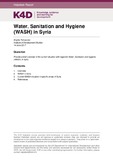| dc.contributor.author | Rohwerder, Brigitte | |
| dc.coverage.spatial | Syria | en |
| dc.date.accessioned | 2018-10-16T09:14:02Z | |
| dc.date.available | 2018-10-16T09:14:02Z | |
| dc.date.issued | 2017-06-14 | |
| dc.identifier.citation | Rohwerder, B. (2017). WASH in Syria. K4D Helpdesk Report. Brighton, UK: Institute of Development Studies. | en |
| dc.identifier.uri | https://opendocs.ids.ac.uk/opendocs/handle/20.500.12413/14089 | |
| dc.description.abstract | Syria is a water scarce country, whose water problems have been compounded by the ongoing conflict and mass displacement. Water infrastructure and water supply have been directly attacked or deliberately turned off as a tactic of war, while lack of investment and maintenance of the system during the conflict have also caused problems. Actors in the WASH Sector and others have been carrying out assessments of the current situation in different areas of the country.
As a result of the conflict two thirds of the population do not have consistent access to safe drinking water. The water network is only able to cover roughly half the needs of beneficiaries, who have to turn to alternative sources for water. Families spend one quarter of their income on clean water. Basic hygiene items are generally available, but are expensive. People living in besieged and hard to reach areas often face problems accessing sufficient water and higher prices for sanitation and hygiene items, when they are available. Poorer households, especially those living in vulnerable shelter types, are more likely to report water shortages or a lack of access to bathing and latrine facilities (as well as damage, and adequacy issues). Displaced households often face more problems accessing water and sanitation. Water shortages are more commonly reported in areas relying on water trucking rather than the water network. People responded to having insufficient water to meet their needs by reducing consumption of water for purposes other than drinking, and modifying hygiene practices. Access to water is a bigger concern than access to sanitation, and households headed by females are particularly affected. Lack of female hygiene products and clean water are reported to have led to health problems for women. Polio remerged in 2013 for the first time in 18 years, and new cases have been confirmed in June 2017. There have also been outbreaks of cholera and other water borne diseases.
In 2016, the UN reports that 13.1 million people were reached with direct humanitarian WASH assistance and 16.4 million people benefited from support to the operation and maintenance of WASH systems. Humanitarian organisations have repaired water and sewage systems; rehabilitated and equipped ground wells; provided water trucking; supported the upkeep of WASH facilities in internally displaced persons (IDP) shelters; provided WASH non-food items (NFIs) such as hygiene kits and jerry cans ; installed water storage tanks; carried out hygiene promotion activities; provided disinfectant to treat public water networks; and provided fuel to operate water pumps. Lack of funding, access and security concerns, and multiple and frequent displacements mean meeting WASH needs is challenging. | en |
| dc.language.iso | en | en |
| dc.publisher | IDS | en |
| dc.relation.ispartofseries | K4D Helpdesk Reports;131 | |
| dc.rights.uri | https://www.nationalarchives.gov.uk/doc/open-government-licence/version/3/ | en |
| dc.subject | Health | en |
| dc.subject | Water | en |
| dc.title | Water, Sanitation and Hygiene (WASH) in Syria | en |
| dc.type | Other | en |
| dc.rights.holder | UK Government | en |
| dcterms.dateAccepted | 2017-06-14 | |
| rioxxterms.funder | Department for International Development, UK Government | en |
| rioxxterms.identifier.project | K4D | en |
| rioxxterms.version | VoR | en |
| rioxxterms.funder.project | 238a9fa4-fe4a-4380-996b-995f33607ba0 | en |

